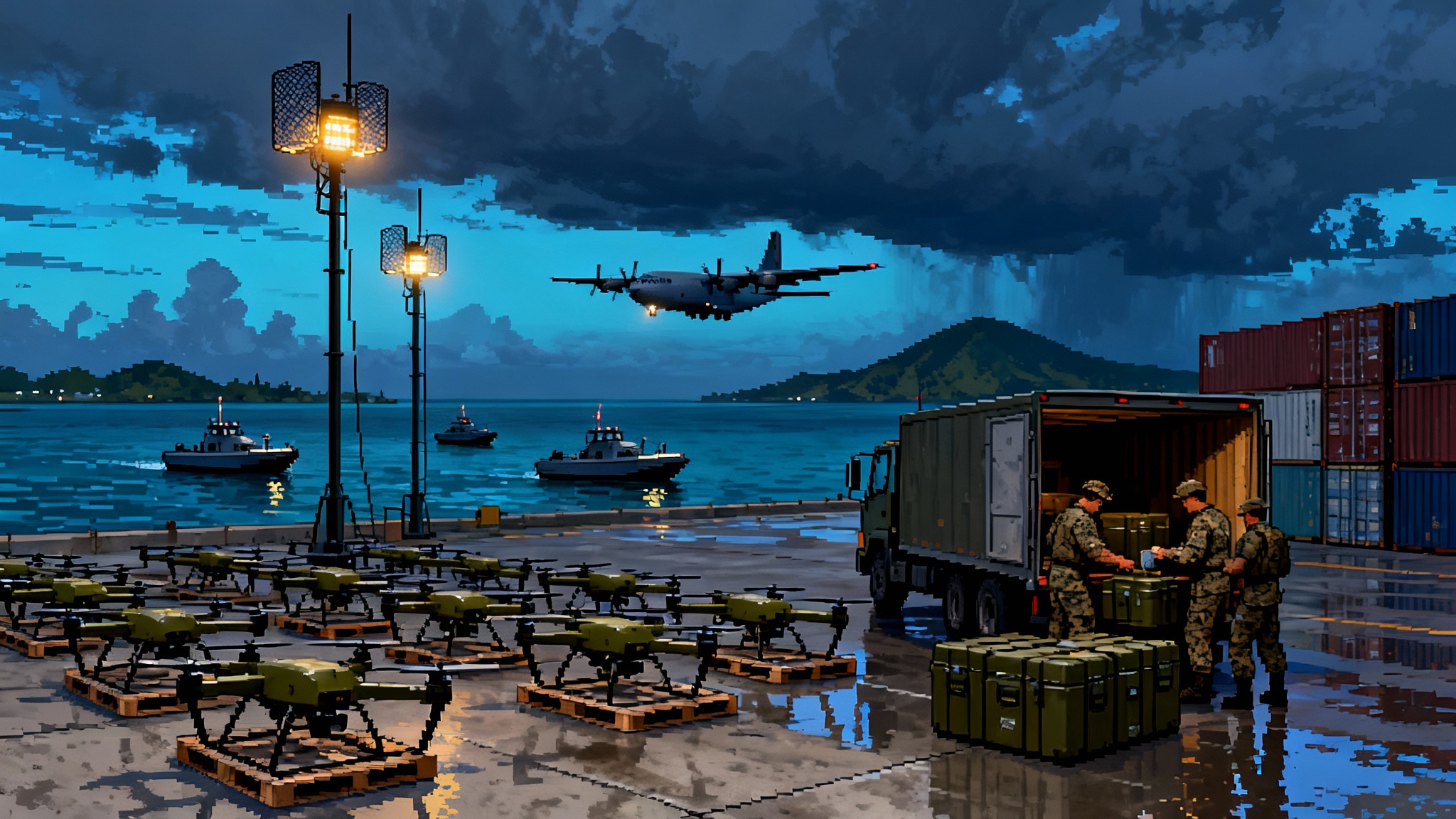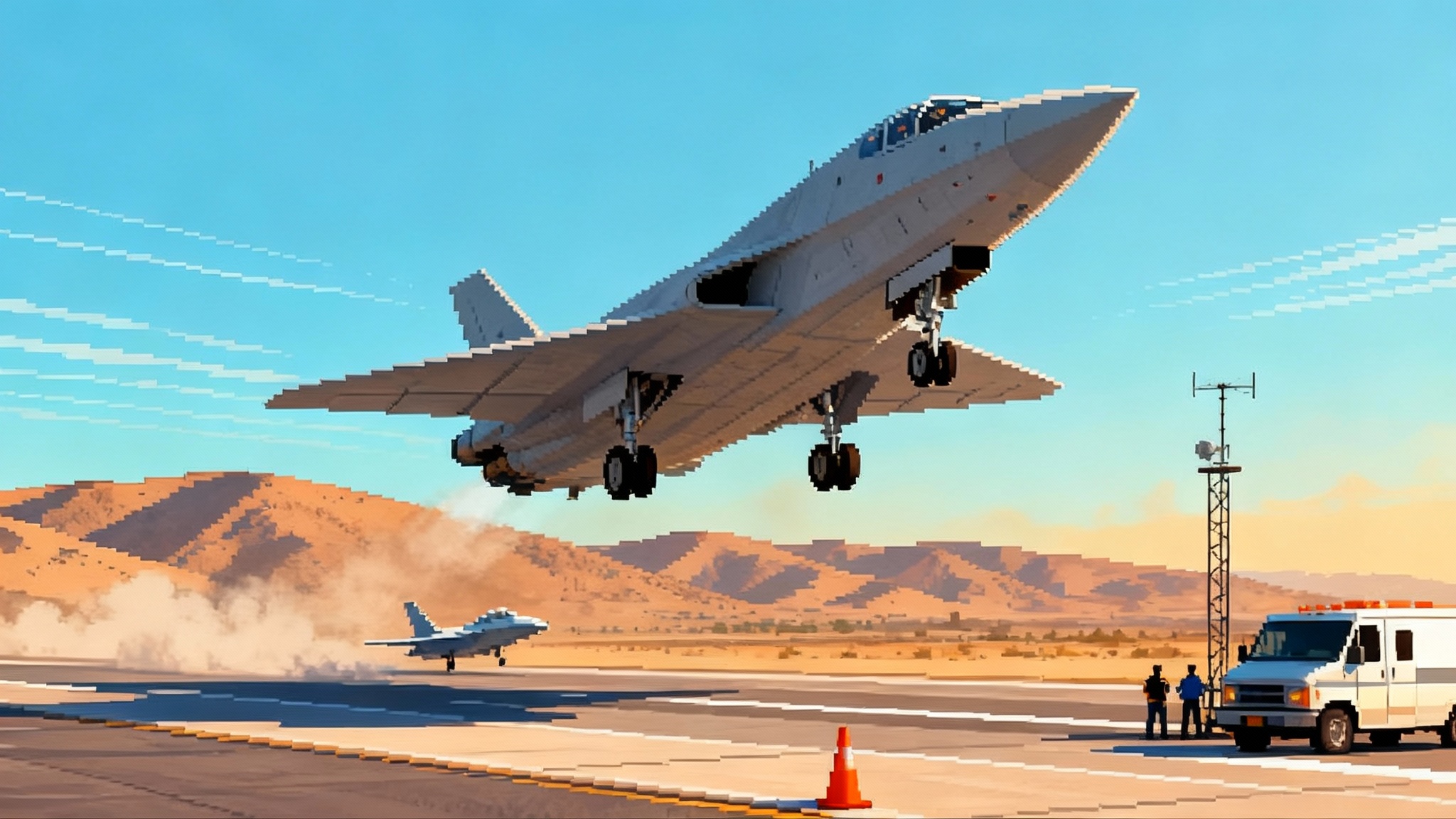LEO Goes Live: SDA Tranche 1 and HBTSS reset hypersonic defense
With the first operational Tranche 1 satellites launched on September 10, 2025 and MDA’s HBTSS prototypes already on orbit, the United States is shifting from radar-first to space-first missile defense. Here is what will change from 2026 to 2028 and how operators can exploit it.
The breakthrough, in one picture
On September 10, 2025, a SpaceX Falcon 9 lifted off from Vandenberg and delivered the first operational satellites of the Space Development Agency’s Tranche 1 into low Earth orbit. It marked the opening shot in a planned months-long cadence of follow-on launches that will add more than 150 spacecraft and begin weaving a persistent data network around the planet. The mission was the first operational step toward a proliferated space layer that can detect, track, and help target advanced missiles, including hypersonic glide vehicles. As acting SDA Director Gurpartap Sandhoo put it, this is when the space layer starts integrating into real operations, as Defense News launch coverage detailed.
At the same time, the Missile Defense Agency’s Hypersonic and Ballistic Tracking Space Sensor, known as HBTSS, already has prototype satellites on orbit. Those satellites began operations after a February 2024 launch and have been collecting data on challenging missile events. The combination is new and powerful. SDA’s proliferated constellation provides global coverage and rapid communications. HBTSS provides the high-precision sight picture an interceptor needs. Together they start to deliver what operators really want: birth-to-death custody of a threat and a clean fire-control-quality track. See the DoD HBTSS launch release.
What just happened, in plain terms
Think of the new architecture like a layered camera crew. The wide crowd shots come from SDA’s Tracking Layer satellites with wide-field infrared sensors. Their job is to spot hot objects as they appear against the cold background of space and hold them in view as they move. The close-ups come from HBTSS. Those sensors are tuned for tighter scenes, delivering the fine detail needed to hand a weapon an accurate aiming cue. The camera operators talk to each other over optical crosslinks and pass footage to editors through a separate SDA Transport Layer, a mesh of communications satellites that moves data to ships, batteries, aircraft, and command centers.
A decade ago, missile defense leaned heavily on a few exquisite radars and a handful of large satellites. That worked for ballistic trajectories that follow predictable arcs. It struggles with hypersonic glide vehicles that maneuver in the atmosphere and can duck under the radar horizon. Proliferated low Earth orbit changes the geometry. Hundreds of satellites, each with modest cost and overlapping fields of view, can look down and sideways at the threat through its entire flight. The network’s job is not one perfect picture from one expensive sensor. It is to assemble a precise track from many views on a fast timeline and keep it coherent while the target tries to disappear.
How space sensors actually catch a hypersonic
A hypersonic glide vehicle can look like a whale moving just below the ocean surface. It sheds a wake of heat and ionized air but can turn and vary its altitude to avoid sonar pings. Wide-field sensors see the wake as it begins. They flag the region of interest, then cue medium-field sensors to zoom in and refine the track. The system keeps asking two questions. Where will it be next. How sure are we. The answers matter because every interceptor has a tight error budget. If the uncertainty grows, you miss.
Here is the choreography for a typical event in the later Tranche 1 timeline:
- SDA Tracking Layer satellites in different orbital planes detect the initial boost and early glide using wide-field infrared sensors. They confirm the event and triangulate a rough track.
- Those satellites cue HBTSS, which points its medium-field sensor to collect higher resolution measurements. That is where the track becomes fire-control quality. It is the difference between knowing a car is on the freeway and reading its license plate at speed.
- The measurements are fused on orbit, packaged, and thrown across the optical mesh to SDA’s Transport Layer. From there, the data rides down to ships, air defense batteries, and command centers using tactical waveforms and gateways.
- If the target maneuvers, a different set of satellites picks up the handoff. The system maintains custody by design, not by luck.
Two features make this possible. First, the network effect of many satellites with overlapping coverage paths. Second, the decision to put computing and crosslinks in space so that the system can compress, fuse, and move data before it ever touches a ground antenna. On the ground, operators see tracks with confidence bounds and recommended shooters rather than raw pixels.
From radar first to space first in 2026 to 2028
The next two to three years are about switching the order of operations. For decades, ships and fixed sites pointed their own radars first and looked for help second. In the Pacific or over Europe, that habit is changing. Space will do the initial detection and cueing. Radars will refine, classify, and support the shot. The effect is practical. Ships can keep their radars in lower-power modes until a space cue arrives. Batteries can posture to cover likely approach paths rather than sweeping empty sky. Multi-mission aircraft can spend more time on their primary task and less time acting as airborne relays.
Consider a destroyer equipped with the Aegis Combat System and the SPY-6 radar. In a hypersonic event, the ship can receive a space-quality cue through SDA’s Transport Layer and Cooperative Engagement Capability. The cue tells it where to look and when. That reduces the search volume and the time to establish a local track. The result is more distance and more engagement windows. For Army units on an island defense mission, cues can reach the Integrated Battle Command System directly. Air Force and Navy aircraft can receive the same information over Link 16 or other tactical data links, which are now being pushed through space relays rather than only terrestrial networks. For ground radar modernization context, see LTAMDS radar enters production.
The payoff is regional. Space-first cueing will not only help a single ship or battery. It will let a theater commander orchestrate many shooters against a raid. The difference is like moving from a pick-up game to a full playbook with a shared clock.
Fire control for Glide Phase Interceptor
The glide phase is the sweet spot for taking a hypersonic weapon off the board. It is earlier than terminal defense, so it protects more targets. It is later than boost phase, so the timeline is more realistic. The Missile Defense Agency’s Glide Phase Interceptor program is the future missile built for that window. Fielding timelines are measured in years, not months. That makes the next phase of the space layer extra relevant. HBTSS is already on orbit and collecting data. The Tranche 1 Tracking Layer begins flying next year. Tranche 2, planned for 2027, will add more sensors, including a subset designed to generate fire-control-quality tracks directly from orbit.
What can be done between 2026 and 2028? Two things matter. First, start closing a fire-control loop with existing effectors such as the Standard Missile-6. Operators can use space-first cueing to create longer and cleaner terminal windows. That is not an academic exercise. It is a way to buy down risk and collect the test data needed for the eventual integration with an actual glide phase interceptor. Second, design and practice the full data path for GPI today. That means rehearsing the handoffs between wide-field sensors, HBTSS, the Transport Layer, and shooter fire control. If the plumbing is proven and the latencies are known, the interceptor can slot in when it is ready. For the sea-based side of the problem, see CPS test and refit.
For readers who want to see the starting point for those HBTSS demonstrations, the Department of Defense confirmed the February 2024 launch of two HBTSS prototypes and laid out a two-year on-orbit test plan in the DoD HBTSS launch release.
The joint kill web goes from sea to theater
The phrase kill web can sound abstract. Here is a concrete version. Imagine a hypersonic glide vehicle launched against a carrier strike group operating east of Taiwan. Within seconds, multiple satellites see the bright boost phase against the dark. Minutes later, the vehicle dips into the atmosphere and begins a weaving glide toward a corridor between two islands. The satellites keep custody and update the track. A destroyer on the western flank receives a cue with a predicted approach window. An Army battery on a nearby island receives the same cue with a recommended area of interest. An E-2D airborne early warning aircraft gets a tasking to stand off and act as an alternate relay to the carrier if sea clutter and line-of-sight limitations start to matter. For theater architecture implications, see Guam kill web pivot.
Now the target maneuvers. The space layer does not care. Different satellites pick up the track from a new angle. The destroyer refines the local track and prepares to launch. The Army battery shifts coverage to protect the logistics hub ashore. The strike group commander has the ability to assign shooters based on geometry, magazine health, and rules of engagement because everyone is looking at the same consistent picture. The web is not a slogan. It is a data structure that allows theater-scale choices at the speed of the problem.
Who builds what
- Space Development Agency: runs the proliferated architecture, split into mission layers such as Tracking and Transport.
- Missile Defense Agency: runs HBTSS and the future Glide Phase Interceptor. HBTSS brings the medium-field, fire-control-quality sensor.
- Launch: SpaceX is the primary launch provider for early tranches.
- Satellites and payloads: York Space Systems, Lockheed Martin, Northrop Grumman, and L3Harris build spacecraft for SDA tranches. General Atomics Electromagnetic Systems builds wide-field and fire-control payloads for future tracking satellites. L3Harris built one of the HBTSS prototypes and is proposing production sensors.
- Ships and batteries: the Navy’s Aegis Combat System with SPY-6 and Standard Missile families, the Army’s Integrated Battle Command System, and Air Force command and control nodes are the initial ground beneficiaries.
Tactics to try in the next 24 months
- Put space cues on the console. Make SDA Transport Layer feeds a default overlay on Aegis, IBCS, and Air Force mission systems during exercises. Measure how quickly operators act on them compared to organic radar search.
- Practice long-range cross-domain handoffs. Use space-derived tracks to move an engagement from sea to land and back again during a single event. That tests timing, data formats, and command authority.
- Fly real-time calibration events. Schedule calibration runs that use aircraft with known infrared signatures to tune wide-field and medium-field sensor fusion. The goal is smaller error ellipses and higher confidence scores.
- Harden the gateways. Treat every space-to-surface gateway as a critical link. Exercise cyber defense on those nodes and develop fallback paths using airborne relays when ground nodes are degraded.
- Build a latency budget and keep it honest. For each theater, publish a measured end-to-end latency from first detect to fire-control update. Update it monthly as nodes are added. If the number grows, fix the path before the next test.
Risks and friction to watch
- Calibration and clutter. Hypersonic vehicles fly in messy air. Sea clutter, cloud tops, and background sources can degrade tracks. Cross-sensor calibration must be routine, not occasional.
- Data rights and formats. Different vendors build different payloads. If mission data formats are not enforced and shared, the constellation becomes a set of islands. Common standards keep the math consistent across sensors.
- Spectrum and interference. Tactical downlinks must live in crowded bands. Plan for contested spectrum and have pre-approved alternate waveforms.
- Processing in the wrong place. If too much fusion happens on the ground, latency grows and custody suffers. Push as much processing as possible into space, then deliver finished products to operators.
- Testing that is too staged. Real value comes from unplanned maneuvering targets and cross-domain tasking. Design tests that are messy on purpose.
What to measure between now and 2028
- Custody time per event. Percent of a missile’s flight with at least two satellites holding track.
- Fire-control conversion rate. Percent of space tracks successfully converted into ship or battery fire-control solutions within a set time window.
- Handoff quality. The error growth when a track moves from wide-field to medium-field to radar. The goal is near zero growth across handoffs.
- Shooter timeline. Seconds from initial space cue to interceptor commit. Publish it for each test series and drive it down.
- Resilience under stress. Track quality and latency during deliberate link cuts and simulated jamming.
The bottom line
The United States is moving the primary sensing burden for hypersonic defense into low Earth orbit. The first operational Tranche 1 satellites are on station. HBTSS prototypes are adding the close-up views that glide phase intercepts demand. In 2026 to 2028, the practical change will not be a single silver bullet weapon. It will be a shift in habit. Space-first cues will become the default. Radars will refine and fire. Shooters will act on a shared picture that theater commanders can shape.
If you work acquisition, lock down data standards, latency budgets, and gateway cyber hardening now. If you command forces, plan exercises that force real cross-domain handoffs. If you build sensors and satellites, bias designs toward in-orbit fusion and interoperability. The kill web is no longer a diagram on a slide. It is starting to hum over our heads. The job now is to tune it, stress it, and make it routine before it is needed for real.







